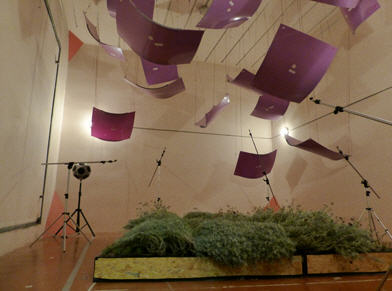Green walls, effective acoustic insulation

Sala reverberacion web
The researcher has concluded that walls comprising plants offer great potential for absorbing noise and could be used as acoustic insulation. Right now, she is conducting thermal studies on them. The researcher believes they could be beneficial in the future to offer a greener image of towns and cities, to improve the life quality of citizens, to save energy, to increase biodiversity, to control rainwater, to lessen town/city noise and to minimize waste and pollution.
The Department of Thermal Machines and Motors of the University School of Mining and Public Works Engineering is exploring the energy efficiency of buildings by conducting tests on various materials. Zaloa Azkorra, an agricultural engineer, began to study the acoustic and energy efficiency of green walls to find out their performance, since these walls consisting of vegetation could be beneficial in improving the life quality of citizens.
Green walls are made up of plant modules: the plants are inserted into polyurethane boxes and are maintained by means of organic irrigation, in other words, they are fed and watered by means of a system similar to the hydroponic one used in greenhouses. It is not easy to grow plants this way or to insert them into a wall.
Noise absorption and insulation have been analysed while meeting the conditions established in ISO standards. The noise absorption test was carried out in a reverberation chamber (a chamber the walls of which are fitted with materials that reflect noise of the same type in all directions), using a range of frequencies. Green walls have thus been found to perform very well in high as well as low frequencies with respect to noise reduction (whereas other materials used in buildings only perform well at either high or low frequencies).
The way green walls may behave as acoustic insulation was also studied: plant modules were fitted onto a laboratory wall and the level of noise insulation was measured. The conclusion reached was that with some slight improvements (like increasing the mass of the modules or covering the space between them) the system can be made more effective and, as a result, the green walls could be suitable for acoustic insulation.
Efficient, but costly
The researcher is proposing that green walls be used in buildings, inside and outside, as they can improve the temperature and, what is more, they can achieve acoustic improvements. What is more, “they are attractive and cool,” said Azkorra. But she also admitted at the same time that having such systems is costly and that, what is more, the systems need to be improved. As Azkorra pointed out, “apart from having plants on the walls, they have to be maintained and that is quite expensive”. So right now she sees no alternative but to fit them in special buildings.
Now that the plant modules have been cultivated, she has begun to carry out thermal studies on them to study what benefits they can bring from the temperature perspective.
Z. Azkorra, G. Pérez, J. Coma, L. F. Cabeza, S. Bures, J. E. Álvaro, A. Erkoreka, M. Urrestarazu. “Evaluation of green walls as a passive acoustic insulation system for buildings”. Applied Acoustics. Volume 89, March 2015, pp. 46-56.
Zaloa Azkorra (Bilbao, 1978) is an agricultural engineer. She lectures in the Department of Thermal Machines and Motors of the University School of Mining and Public Works Engineering of the UPV/EHU. She wrote up her thesis under the supervision of Aitor Erkoreka. She conducted the tests at the Quality Control Laboratory in the TECNALIA Building in the Department of Acoustics. She also had the help of Dr Miguel Urrestarazu of the University of Almeria to obtain the modules and the plants for carrying out the tests.
Media Contact
All latest news from the category: Architecture and Construction
Newest articles

Silicon Carbide Innovation Alliance to drive industrial-scale semiconductor work
Known for its ability to withstand extreme environments and high voltages, silicon carbide (SiC) is a semiconducting material made up of silicon and carbon atoms arranged into crystals that is…

New SPECT/CT technique shows impressive biomarker identification
…offers increased access for prostate cancer patients. A novel SPECT/CT acquisition method can accurately detect radiopharmaceutical biodistribution in a convenient manner for prostate cancer patients, opening the door for more…

How 3D printers can give robots a soft touch
Soft skin coverings and touch sensors have emerged as a promising feature for robots that are both safer and more intuitive for human interaction, but they are expensive and difficult…





















